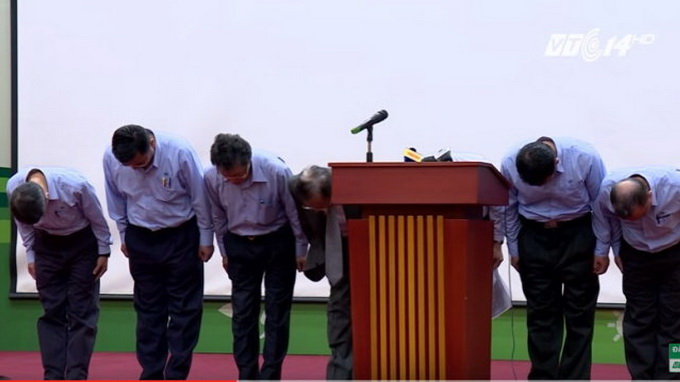The Vietnamese steel business of Taiwan’s Formosa Plastics Group is the ‘culprit’ of a spate of fish deaths in central Vietnam, the government said in a meeting on Thursday, as the firm’s top executive admitted the wrongdoing and pledged a hefty monetary compensation.
The meeting in Hanoi was held to announce the official results of a government-backed inspection into the mass fish deaths that hit four central Vietnamese provinces, namely Ha Tinh, Quang Binh, Quang Tri and Thua Thien-Hue, between April and May.
The inspection, conducted by more than 100 scientists and whose results have been questioned by international experts, found that wastewater from the steel mill, operated by Hung Nghiep Formosa Ha Tinh Steel Co. Ltd., was to blame for the fish kill, Minister Mai Tien Dung, head of the Government Office, said at the meeting.
The wastewater dumped by the steel plant, located at Vung Ang Economic Zone in Ha Tinh, included such toxic substances as phenol and cyanide, which combined with hydro to form a mixture carried by the current to Thua Thien-Hue, killing numerous fish and aquatic creatures along its way.
 Formosa's steel mill in Ha Tinh
Formosa's steel mill in Ha Tinh
The Ministry of Natural Resources and Environment has given the objective and scientific evidence to both Formosa Plastics Group and its Vietnamese unit.
On Tuesday, Hung Nghiep Formosa Ha Tinh took responsibility for causing the fish deaths in the four provinces.
At the meeting in Hanoi, a Formosa representative provided a pre-recorded video, showing the company’s leaders bowing and apologizing to the Vietnamese people for their wrongdoings.
The Hung Nghiep Formosa Ha Tinh chairman, whose Vietnamese name is Tran Nguyen Thanh, admitted at the meeting that mistakes stemming from his plant triggered the mass fish deaths, according to the footage.
Thanh said the mistakes were made by the sub-contractors selected by the company, so Hung Nghiep Formosa Ha Tinh is to be held accountable.
He conveyed an apology to the Vietnamese people and government, particularly fishermen of the four affected provinces.

Credit: VTC14
Five-point commitment
After admitting its link to the fish deaths, Formosa also made a five-point commitment to correct its wrongdoings and resolve the environmental impacts.
The company first publicly apologizes to the Vietnamese government and people for causing severe environmental pollution, and pledges a total compensation of VND11.5 trillion, or US$500 million. The money will be used to support fishermen to switch to other jobs and to purify the polluted water.
The third commitment is that Formosa will improve its technology to ensure wastewater is completely treated before being discharged to the environment.
Formosa also promises to cooperate with Vietnamese agencies to build a set of sustainable solutions for preventing pollution, so as not to give rise to any other environmental scandal.
The Taiwanese firm finally guarantees to fulfill the said commitments; otherwise, it will bow to any penalties by the Vietnamese side.
Speaking at the meeting, Vietnamese Prime Minister Nguyen Xuan Phuc requested that Formosa fulfill its commitments properly, especially the compensation duty.

How the fish kill happened
In early April, dead fish started washing ashore the beaches in Ha Tinh Province, especially the area near the Vung Ang Economic Zone, where Formosa places its steel mill. The phenomenon quickly spread to nearby provinces, including Quang Tri and Quang Binh.
On April 20, at the Binh An beach in Thua Thien-Hue Province, locals found a number of dead fish washed ashore, marking the arrival of the epidemic in the province.
In late April, Deputy Minister of Science and Technology Pham Cong Tac said as of April 26, all tests and analysts confirmed that such reasons as seismic, temperature shock or diseases could be ruled out.
On May 1, Prime Minister Phuc visited Ha Tinh, insisting that the cause behind the fish deaths be found. “The people need a scientific and specific conclusion on the case,” the premier underlined.
On May 9, PM Phuc signed a directive to provide urgent support for fishermen in the four affected provinces.
On May 29, local media reported that the fish deaths, whose reasons were then unknown, had discouraged local consumers from eating fish and seafood, affecting traders not only in central Vietnam but also in Ho Chi Minh City.
On June 2, the government held a press meeting to announce that the cause behind the deaths had been identified, but it was being challenged by experts in order to ensure it was based on scientific, legal, and objective grounds before a final conclusion was confirmed.
Like us on Facebook or follow us on Twitter to get the latest news about Vietnam!























































